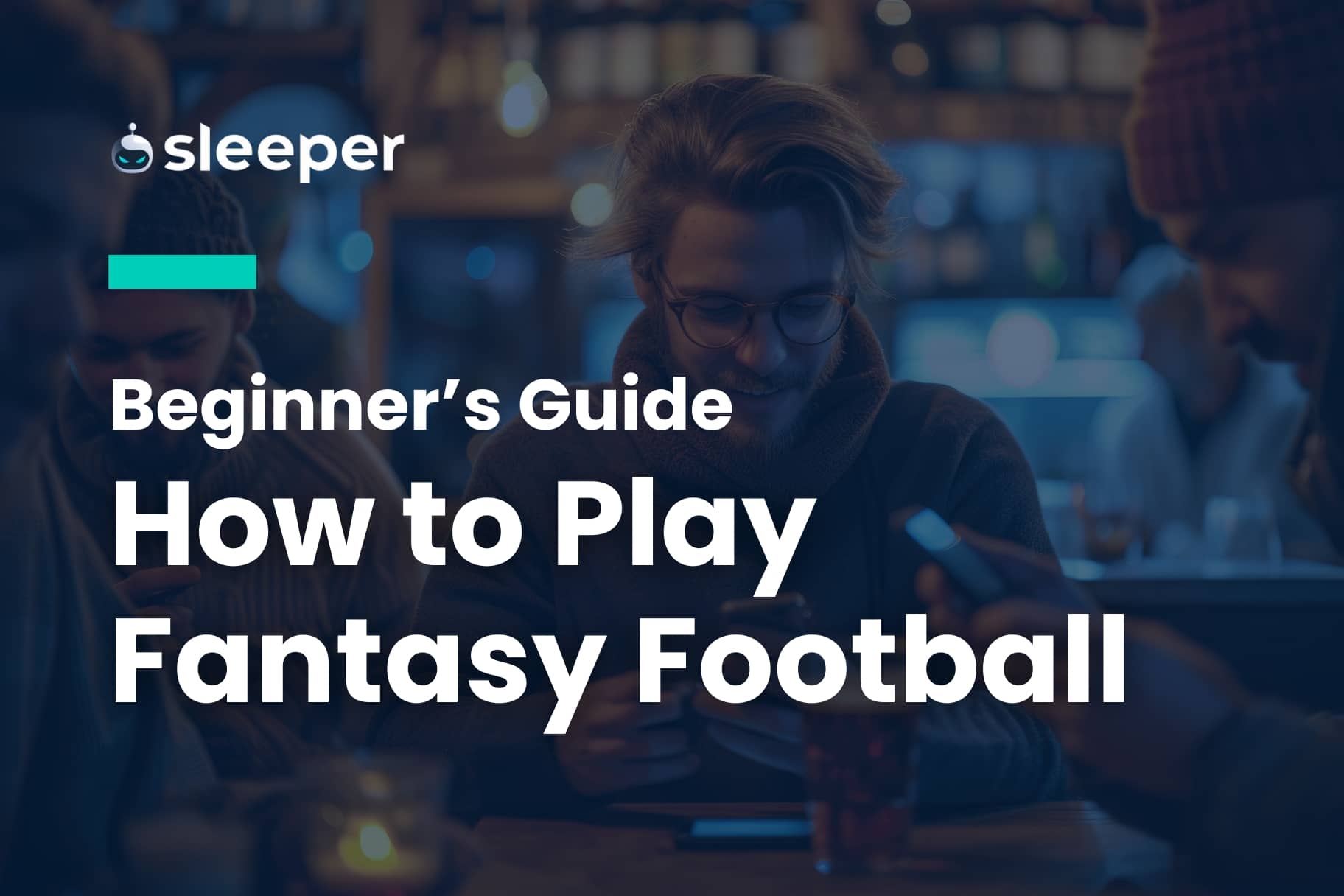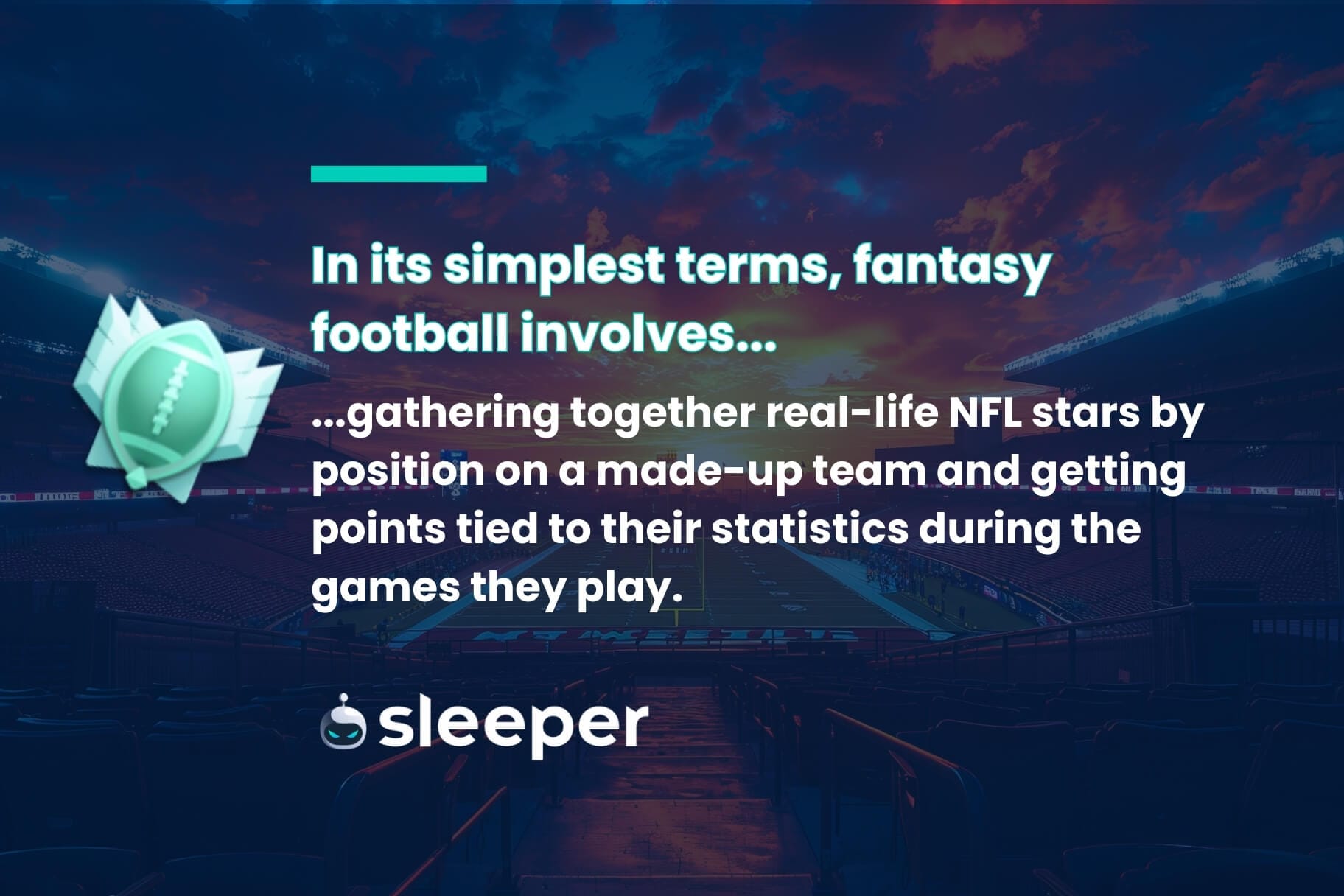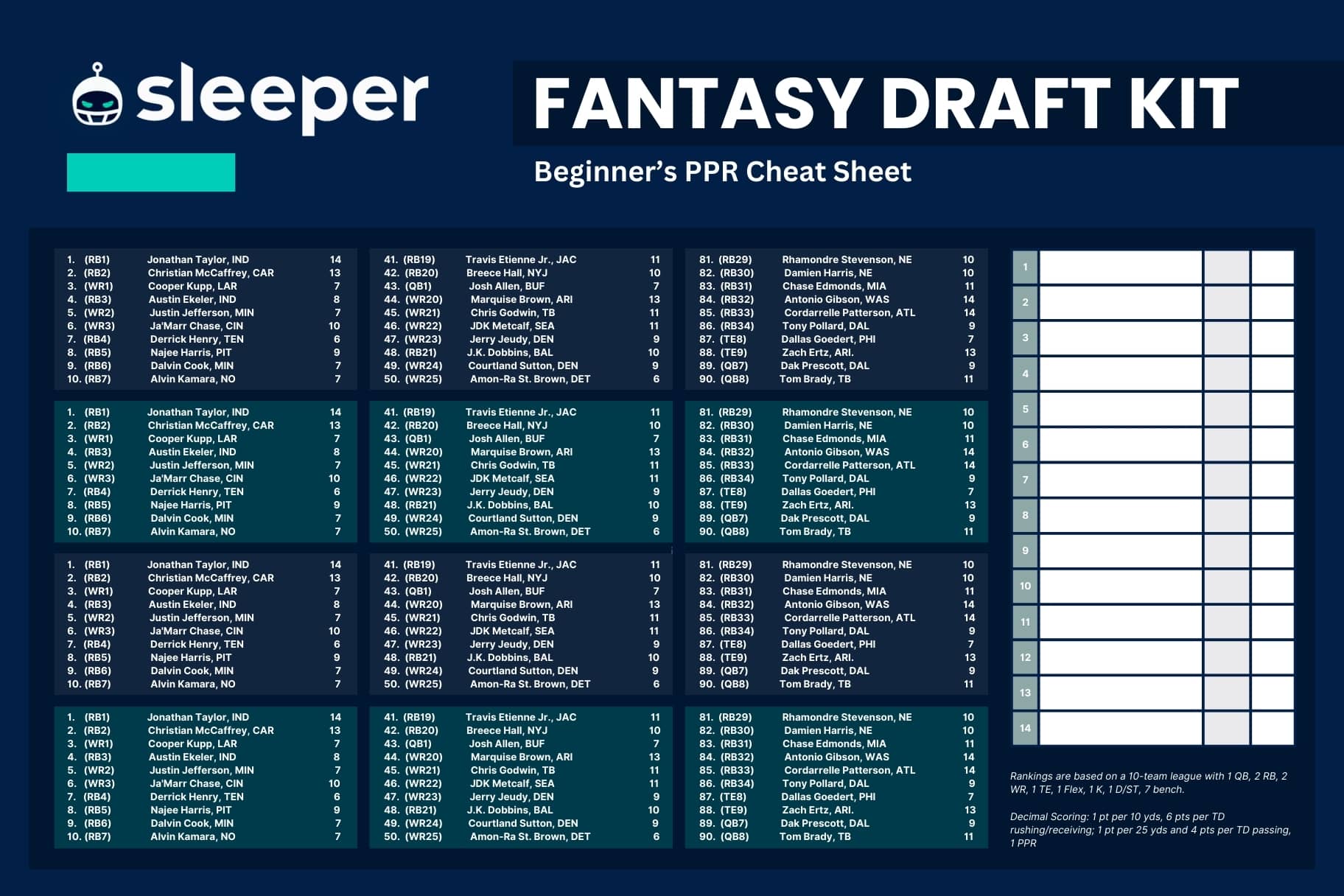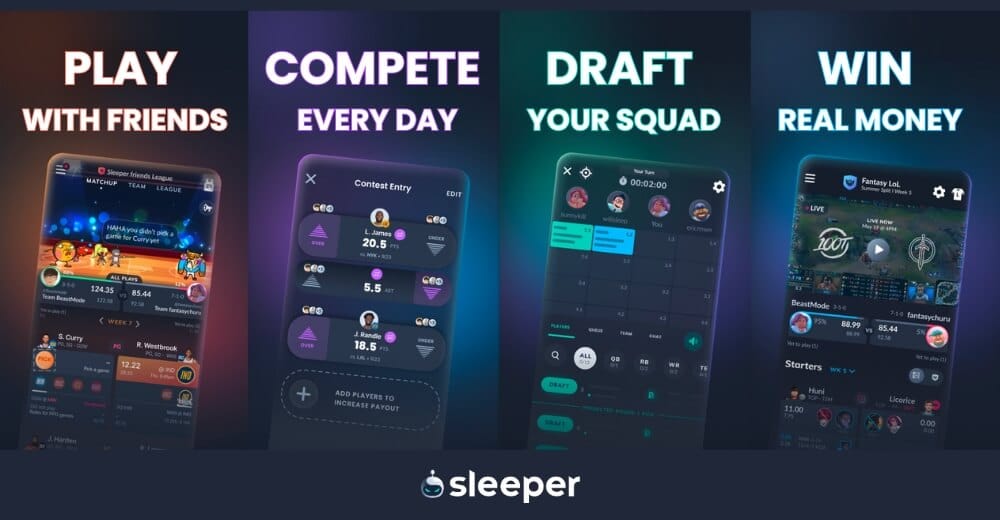Are you a football fan eager to dive into fantasy football but unsure where to start? This article is your ultimate tool for learning the fantasy ropes and winning your league.

Fantasy football is part of the lifeblood of the NFL. You can’t watch a game these days without encountering its fantasy implications, either in the ways announcers talk or in the graphics that appear on your screen.
Why? Because it’s fun, easy to play and has driven a huge increase in the popularity of professional football. If you’ve always wanted to play but aren’t fully sure how to get started, you’ve come to the right place. We’ll sketch out from start to finish how to create a team, join a league, draft a squad and compete against friends, coworkers or complete strangers in pursuit of fantasy glory.
Don’t miss: What Is Fantasy Football?
In its simplest terms, fantasy football involves gathering together real-life NFL stars by position on a made-up team and getting points tied to their statistics during the games they play.
In a head-to-head league, your fantasy team will face another during each week of the NFL season, and whichever team’s scoring output is higher wins that week.
At the end of the fantasy regular season, the teams with the best record (usually four or six teams, depending on league size) make the playoffs and square off in head-to-head matchups until a champion emerges.
There’s much to cover in more detail about how to play fantasy football, so let’s dive in.
How to Play Fantasy Football, Step-By-Step
Every successful season has to start somewhere, so here’s a step-by-step approach for starting a team and cultivating it.
Step 1 : Join a league
It’s the simplest step, but whether it’s via Sleeper or another platform, you'll have to sign up and either join a public league against strangers or a private league via commissioner invite. The latter usually involves people you know well, be it school friends, extended family, coworkers or, you get the point.
From there, the league commissioner will set a draft date, and it’ll be on you to research and prepare so you don’t enter your draft blindly without a clue about the players you want to target.
Step 2: Choose from one of the multiple kinds of leagues
Leagues vary by size and format. They’re usually between 10 and 12 teams, but there’s no official minimum or maximum. The size of the league will determine how thinned out the player pool is during and after the draft.
There’s also the matter of which drafting method your league chooses. The most common kinds are:
- Snake draft – there’s a set order for the first round, it reverses for the second, and so on
- Auction draft – every manager has a set budget of fictitious money and can bid for every player, as long as they stay within the confines of the budget cap
No matter the draft type, there’s also the matter of the scoring system. For example, does your league give 0.5 points or 1 point for a reception (half PPR or full PPR) or none at all?
You can determine which is the preferred method for you and your leaguemates by reading our guide on Fantasy Football Scoring.
Step 3: Name your team
Don’t overlook one of the most fun steps in the process. Fantasy team names can be mundane if you’d prefer, but it’s more enjoyable when they’re inside jokes among friends or a hilarious nod to a pop culture reference. Names often involve puns or wordplay that invoke the players, coaches or trends in the NFL. Fantasy football team naming has become a bit of an art form and is where you can flex your creative muscles.

Step 4: Research available players
You don’t want to go into a draft unprepared. Make sure you know who is injured or suspended entering the season and how that will affect player availability. Read up on the players who changed teams and the rookies entering the league and what it means for their fantasy outlook. Above all, make sure you know your league’s scoring settings, so you can properly rank and value positional needs and the players to satisfy them.
There’s no shortage of research content, either via video, audio or written word, to cover everything from the basics to the nitty gritty backed by advanced metrics. How deep you want to go on all of that is up to you. The Sleeper app has a number of research tools to help you get ready.
One easy step to take to get proper context entering your draft is pulling up lists of player ADP (average draft position). Just make sure that the specs of the chart you’re looking at match your league size and scoring settings. An ADP cheat sheet can help you get a rough idea about who will be available when it’s your turn to pick, assuming you’re conducting a snake draft. You don’t have to adhere to ADP order, of course, but if you’re a beginner, it’s an especially useful tool.
For auctions, you can easily find consensus lists for player values, but, again, make extra sure that the settings for what you’re researching sync up with those of your league.
When you've done enough research to be dangerous, consider doing a few mock drafts. Mock drafts are a great way to simulate what draft day will be like, where players may get taken and where hidden value may lie. Sleeper lets you do as many mock drafts as you want. And it's 100% free.
Step 5: Draft your team
Your league’s draft order will likely be in advance of draft day (if it’s a snake draft), so you should be able to have an idea of who will fall to you on your first pick, and where you’ll want to reach for a player who might not be available when you’re picking next.
When your team is on the clock, your heart rate will go up and you’ll make a selection before waiting for it to be your turn again. If the player you want was just picked by a foe, try not to panic — other viable options are available, and if you’ve done the research, you’ll be prepared.
If you’re not able to be at the draft or you have a conflict in the moment, fear not: there is always the “autodraft” option, in which the league platform will automatically take the highest-ranked player left on the board for you. Autodrafts may be set to select the highest-ranked option at a position you haven’t yet filled to ensure your roster is not incomplete. You can customize your own player rankings and set your status to autodraft in your preferred priority if you need to miss some or all of the draft but still want your fingerprints on your team.
Check our fantasy football draft order guide for a more complex look at where you’ll want to target certain positions in your draft as you build out your team.
Note: Be wary that the platform you’re using to draft may have a different ranking in the draft room than the one you used to prepare. In-house rankings are quite influential during a live draft and may ruin some plans you had, if you thought a certain running back might slide a bit longer only to be ranked higher by that specific platform.
Step 6: Watch NFL games each week to uncover opportunities and analyze results
The best way to assess your own players and those of your opponents is by watching NFL games every week, or at least combing through the box scores. That’ll let you determine trends, see which players may be underperforming or overperforming and analyze your own squad to figure out where you want to make in-season roster moves.
Step 7: Improve your team by adding, dropping and trading players
The draft is only the first part of the process. Throughout the season you can tweak your squad in various ways, and it’s not uncommon that your roster at the end of the season hardly resembles the one you chose back in August or September.
Most leagues have a waiver wire and either an order or bidding process. The former entails putting a claim on a player you want to add to your team. If you have a higher priority in the order than other managers who also put in claims on that player, you’ll get him and then go to the back of the order.
The waiver order typically starts out as the reverse order of the first round of your snake draft; i.e. if you had the 12th pick in a 12-team league, you’ll start the season with the top waiver position. Claims are typically due and processed in the wee hours of Tuesday night/Wednesday morning.
The bidding version is quite straightforward. If managers are interested in a player on waivers, they can submit a bid out of a budget of faux money, and the player goes to the highest bidder. Sleeper uses a blind bidding system where no one knows how much other teams may be bidding for the same player.
Strategy is key when it comes to waiver wire pickups. Use your priority too soon or bid too high on a player, and you might miss the league-winning difference-maker who becomes available down the line. It’s all about your immediate need and roster urgency.
Regardless, once players clear waivers, they are deemed free agents and are able to be added by any team, without a claim or bid, until the next waiver period begins.
In order to add a player, you’ll likely have to drop another in order to stay at your team’s maximum roster size (although some leagues do have additional spots reserved to stash injured players, which opens up places on the active roster).
One strategy for certain positions is called “streaming,” where fantasy owners will regularly swap out players on a week-to-week basis instead of relying on one regular. That’s most common among kickers and defense/special teams units, but if one of your stars gets injured, you could quickly find yourself in an unenviable — yet not entirely untenable — position.
Step 8: Win your league
If you’ve paid close attention, drafted well, made shrewd moves and been a little lucky along the way, you’ll be positioned for success. Most leagues have their playoffs between Weeks 15 and 17 in the NFL, leaving Week 18 out of the calculus.
That’s because it’s the most unpredictable week of the season. Playoff-bound teams (in real life) may be resting their top stars — who, in turn, are the top fantasy stars — while those with nothing to play for could treat the week like preseason, as it relates to trotting out backups and no-names. The competitive stakes across the league typically end in Week 17, so it makes sense for your fantasy league’s biggest week to match that.
Fantasy Football Cheat Sheet
Many managers will make use of a cheat sheet before and during a draft. It’s the best way to organize a lot of information and provide utility on draft day, so you can feel like you’re in control and have a handle on everything as it unfolds.
Overall rankings, rankings by position, ADP, projected points, bye weeks, consensus auction values — basically all the information that could help inform your draft decisions can be at your fingertips in the form of a handy, customizable spreadsheet so you’re not forced to scramble when you’re on the clock.

Fantasy Football Bye Weeks
Bye weeks are when NFL teams are off during the season. They typically occur between Weeks 5 and 14 in the NFL season, and they have a direct impact on fantasy teams. That’s because if NFL teams are off, then their players are too, and that leaves a hole in your fantasy lineup.
It’s important to take bye weeks into account and anticipate them both while drafting your team and multiple weeks ahead of time after the season has begun, so you can secure backup options on your bench and be prepared to plug any holes with a viable solution.
Fantasy Football Trades
Put on your GM hat for real by scoping out other squads in your league, seeing where another manager’s roster surplus and weakness sync up with yours and pulling the trigger on player trades.
It’s rather easy to do: you select the players you want and what you’re willing to give up, and you offer it through your league's trade platform.
Tip: Be smart and genuine about your trade offers. Don’t offer two bench players for Christian McCaffrey or a kicker for Tyreek Hill. That doesn’t help anyone, and it’s not realistic. It also helps to reach out to another owner directly first to discuss potential deals as opposed to making an offer out of the blue. That will help you find common ground and not waste each other’s time with a rogue approach.
Where to Play Fantasy Football
There are a number of different platforms where you can play fantasy football. Sleeper is chief among them, offering free, season-long leagues to anyone who wants to get involved.
Sleeper has a sleek interface and smooth user experience and it offers fun wrinkles such as dynamic chat and messaging capabilities to make your league feel more interactive and social. The player board while your league is drafting is also incredibly helpful and appealing to the eye, the news feed keeps you up to date on the latest and the ad-free experience puts it over the top.
Consider Daily Fantasy Sports (DFS)
If you're not ready to make the commitment on a full-season fantasy league, consider playing DFS. DFS platforms like Sleeper Picks give you the opportunity to select players for just one game. You'll learn a lot about picking players and assessing statistics, have a chance to win real money and you can play again and again without having to wait until next season.
Learn more: What Is DFS?
Fantasy Football Frequently Asked Questions
How can I prepare for fantasy football?
The best ways to prepare for your draft and season are by reading trusted voices or guides to get a better understanding of the landscape. You should also be 100% sure of your league’s roster and scoring settings, so you know how to properly assess player and positional values.
What positions are drafted in fantasy football?
Standard league rosters feature one quarterback, two running backs, two wide receivers, a tight end, a flex (one of RB/WR/TE), a kicker and a DST (defense/special teams unit). Beyond that, most feature roughly six or seven bench spots, which can be used on any position.
There are variations beyond that, depending on your league’s preferences. Some may field a third starting wide receiver or a second flex. Another twist is that of the superflex, in which you’re able to start a quarterback in a flex spot.
Is it hard to play fantasy football?
It can be, depending on who you’re going up against. If there are industry pros or diehard football fans who hop on the key free agents or swoop in with waiver claims within seconds of players’ sudden relevancy, you could be in for an uphill battle.
If you’re with participants of a similar skill and knowledge base, then it’s more of an open competition. You’ll need to stay attentive all season long, and regardless of how your draft goes, you’ll need to be ready to make moves.
There’s also plenty of luck involved, so while you may take a given week’s result harshly, remember that it’s not your fault the opposing team’s RB feasted in garbage time of a blowout, or that game script unexpectedly went against your QB.
You also might have drawn the league’s highest scorer on a certain week when you would have beaten eight other managers if the matchups were different. There’s only so much you can control.
Turn Fantasy Football Into Your Reality
Fantasy football is a fun way to add enjoyment to the NFL season. It’ll make you care about games, teams and players you otherwise wouldn’t pay much attention to, and it’ll give you personal investment in how the season plays out.
To get started, you can join Sleeper, either by signing up on the website or downloading the app, to begin playing fantasy football and enjoy all the benefits and special features that only Sleeper offers.
It’s the best platform to play fantasy football — both for DFS and season-long leagues — and differs from competitors by all the reasons stated above. It’s engaging for you and your leaguemates, it’s incredibly easy to use and it’s packed with the stats, news and features that’ll give you a fulfilling experience.




